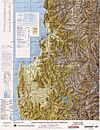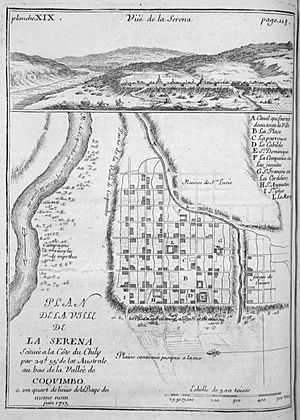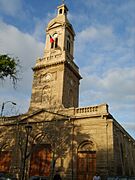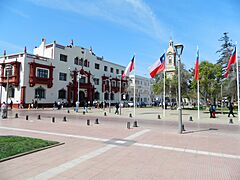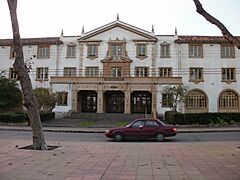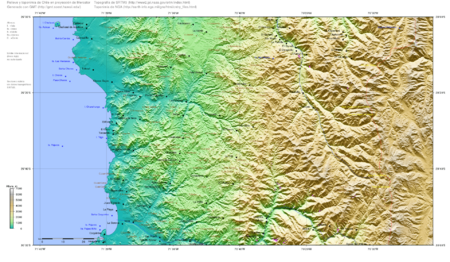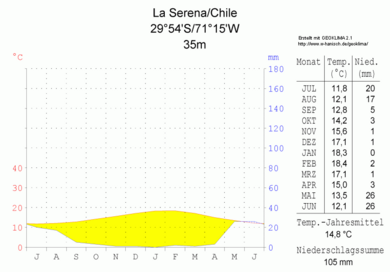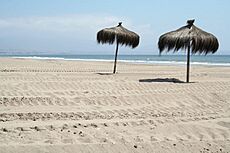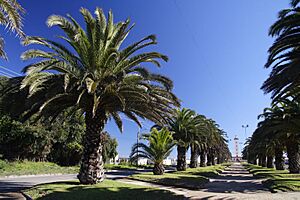La Serena, Chile facts for kids
Quick facts for kids
La Serena
|
||||||
|---|---|---|---|---|---|---|
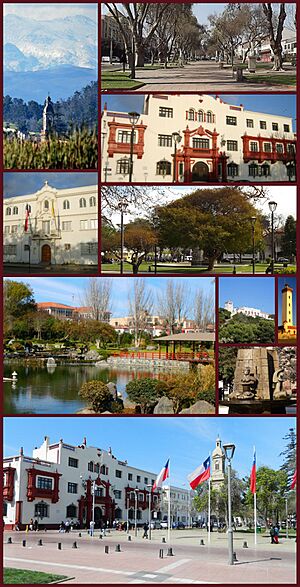
Archbishopric of La Serena, Court of Appeals, Landscape, Japanese Park, Plaza de Armas, Lighthouse, Avenida Francisco de Aguirre, Fountain of the Plaza de Armas, Court and the Plaza and University of La Serena (Campus Colina El Pino)
|
||||||
|
||||||
| Country | ||||||
| Region | ||||||
| Province | Elqui | |||||
| Founded | 1544 | |||||
| Named for | La Serena, Spain | |||||
| Government | ||||||
| • Type | Municipality | |||||
| Area | ||||||
| • Total | 1,892.8 km2 (730.8 sq mi) | |||||
| Elevation | 28 m (92 ft) | |||||
| Population
(2012 Census)
|
||||||
| • Total | 198,163 | |||||
| • Density | 104.6930/km2 (271.154/sq mi) | |||||
| • Urban | 147,815 | |||||
| • Rural | 12,333 | |||||
| Demonym(s) | Serenean | |||||
| Sex | ||||||
| • Men | 77,385 | |||||
| • Women | 82,763 | |||||
| Time zone | UTC−4 (CLT) | |||||
| • Summer (DST) | UTC−3 (CLST) | |||||
| Postal code |
1700000
|
|||||
| Climate | BWk | |||||
La Serena is a lively city in northern Chile. It is the capital of the Coquimbo Region. Founded in 1544, it is Chile's second oldest city. Only the capital, Santiago, is older. In 2012, about 200,000 people lived there. La Serena is one of the fastest-growing areas in Chile.
The city is a popular spot for tourists. Many people from Chile and Argentina visit, especially in summer. They come to enjoy the beautiful beaches. La Serena is also home to the University of La Serena. It is a major center for the Catholic Church in Chile.
Contents
History of La Serena
The area where La Serena now stands was once home to a native village. It was called Viluma or Vilumanque. This name means "Snakes and condors" in the Mapudungún language.
Founding the City
Pedro de Valdivia, a Spanish leader, ordered La Serena to be built. He wanted a sea route between Santiago and Lima. This route was important for his troops to rest and get supplies. Captain Juan Bohón founded the village. He named it "Villanueva de La Serena." The exact date is debated, but it was likely in 1544.
Just five years later, in January 1549, a native uprising destroyed the village. Almost all the Spanish people were killed. Pedro de Valdivia then ordered Captain Francisco de Aguirre to rebuild it. This happened on August 26, 1549. The city was renamed San Bartolomé de La Serena. This name honored the city's new patron saint. The rebuilt city stood where the Plaza de Armas is today.
A few years later, on May 4, 1552, King Carlos I of Spain officially made it a city. One reason for building La Serena was to control Mapuche groups. These groups had moved north after the Spanish founded Santiago in 1541. Many Mapuche groups left their farming lands. They moved to remote areas to avoid the Spanish.
Challenges and Changes
In the 1600s, pirates often attacked La Serena. Famous pirates like Francis Drake and Bartholomew Sharp caused fear. Sharp even burned and looted parts of the city in 1680. These attacks forced the city to improve its defenses by 1700.
Besides pirate attacks, a huge earthquake almost destroyed the city in 1730. Later, during the Revolution of 1859, rebels took over the city. These forces were led by Pedro Leon Gallo. However, an army from Santiago defeated Gallo's forces. They then occupied La Serena.
Architecture and Design
Between 1948 and 1952, President Gabriel González Videla started a special project. It was called the Plan Serena. This plan updated the city with new buildings and designs. It gave La Serena a unique look. The city became known for its services and its special architectural style. This style is called Colonial Revival.
La Serena is home to the Roman Catholic Archdiocese of La Serena. The main church, called the cathedral, was built in the 1800s. It is made of strong stone. This is important in a country with many earthquakes. The cathedral has survived many tremors with almost no damage. Many churches in the city, old and new, create a unique view. This is why La Serena is often called "The City of Churches."
Building Materials and Style
Traditional buildings in La Serena have a late 1800s style. They were often built with wood from Oregon, USA. This wood came to Chile as weight in ships. These ships then loaded copper and other minerals in the nearby port of Coquimbo. The use of Oregon pine and adobe bricks gives the city its special look.
Many small, valuable churches are also found here. They are built from sedimentary stone. This stone comes from about 5 kilometers north of the Elqui River. It has a special color and texture from tiny shells. These churches are around 350 years old. Many have been restored to their original beauty. Some famous ones are San Francisco, San Agustín, and Santo Domingo.
Around 1920, iron mining brought new money and people to the city. This led to more changes in the city's buildings. Today, La Serena has its own "neocolonial" style. It keeps old colonial buildings. It also adds modern ones that fit the colonial look. In the city center, buildings were limited to eight stories high until 2008. But along the coast, near Avenida del Mar, many tall buildings are now being built.
-
Lighthouse of La Serena ("El Faro").
Population and Growth
In 2012, La Serena had about 198,164 people. The larger Greater La Serena area had around 400,000 residents.
According to the 2002 census, 160,148 people lived in the city. About 147,815 (92.3%) lived in urban areas. The rest, 12,333 (7.7%), lived in rural areas. Between 1992 and 2002, the population grew by 32.6%. This made La Serena one of the fastest-growing areas in Chile.
La Serena is part of a large urban area with nearby Coquimbo. This combined area has about 300,000 people. Some main parts of La Serena include El Centro (downtown), Peñuelas, San Joaquín, La Florida, Las Compañías, Cerro Grande, La Antena, and El Milagro. The areas around the city are mostly used for farming. Many chirimoyas, avocados, and oranges are grown here. There are also many eucalyptus forests. These areas can have wildfires in the summer (January–February).
Geography and Climate
The city of La Serena covers an area of 1892.8 square kilometers. It is built on ocean terraces. You can clearly see these terraces from the coast to the eastern side of the city. Other parts of the city are on small hills, in valleys, and on plains.
The city is divided into several sections. To the north are the High and Low Company areas. To the south are La Pampa, San Joaquin, and El Milagro. East of the city are La Antena, Juan XXIII, La Florida, Colina El Pino, and the University District. To the west is the Avenida del Mar area.
Weather in La Serena
La Serena has a cool desert climate. This means it has clear seasons. In summer (December-February), there is almost no rain. Mornings are often cloudy and misty. This usually clears by noon, leading to sunny days around 22°C (72°F).
In winter (May-August), temperatures drop to between 7°C and 16°C (45-61°F). Because it's on the coast, the ocean keeps temperatures mild. The cold Humboldt Current also helps. Winter is the rainy season. La Serena usually gets about 100 mm (4 inches) of rain each year. Some years have been much wetter, like 1888 with 417 mm (16 inches). The driest year was 1979, with only 4.5 mm (0.18 inches) of rain.
| Climate data for La Serena (1991–2020, extremes 1954–present) | |||||||||||||
|---|---|---|---|---|---|---|---|---|---|---|---|---|---|
| Month | Jan | Feb | Mar | Apr | May | Jun | Jul | Aug | Sep | Oct | Nov | Dec | Year |
| Record high °C (°F) | 27.2 (81.0) |
26.9 (80.4) |
25.6 (78.1) |
28.5 (83.3) |
26.6 (79.9) |
28.4 (83.1) |
28.2 (82.8) |
27.0 (80.6) |
27.1 (80.8) |
26.2 (79.2) |
25.2 (77.4) |
25.1 (77.2) |
28.5 (83.3) |
| Mean daily maximum °C (°F) | 21.5 (70.7) |
21.5 (70.7) |
20.2 (68.4) |
18.4 (65.1) |
16.9 (62.4) |
15.8 (60.4) |
15.4 (59.7) |
15.8 (60.4) |
16.4 (61.5) |
17.4 (63.3) |
18.6 (65.5) |
20.0 (68.0) |
18.2 (64.8) |
| Daily mean °C (°F) | 17.9 (64.2) |
17.9 (64.2) |
16.7 (62.1) |
14.9 (58.8) |
13.3 (55.9) |
12.0 (53.6) |
11.4 (52.5) |
11.9 (53.4) |
12.6 (54.7) |
13.6 (56.5) |
14.9 (58.8) |
16.4 (61.5) |
14.5 (58.1) |
| Mean daily minimum °C (°F) | 14.3 (57.7) |
14.3 (57.7) |
13.3 (55.9) |
11.3 (52.3) |
9.7 (49.5) |
8.2 (46.8) |
7.4 (45.3) |
8.0 (46.4) |
8.9 (48.0) |
9.8 (49.6) |
11.3 (52.3) |
12.8 (55.0) |
10.8 (51.4) |
| Record low °C (°F) | 1.4 (34.5) |
9.1 (48.4) |
0.0 (32.0) |
3.9 (39.0) |
0.9 (33.6) |
1.0 (33.8) |
0.0 (32.0) |
0.2 (32.4) |
0.9 (33.6) |
0.8 (33.4) |
1.0 (33.8) |
1.2 (34.2) |
0.0 (32.0) |
| Average precipitation mm (inches) | 0.2 (0.01) |
0.1 (0.00) |
1.1 (0.04) |
0.8 (0.03) |
13.1 (0.52) |
29.9 (1.18) |
17.1 (0.67) |
12.7 (0.50) |
4.2 (0.17) |
3.3 (0.13) |
0.4 (0.02) |
0.3 (0.01) |
83.2 (3.28) |
| Average precipitation days (≥ 1.0 mm) | 0.0 | 0.0 | 0.1 | 0.2 | 1.0 | 1.8 | 1.6 | 1.3 | 0.7 | 0.4 | 0.1 | 0.0 | 7.2 |
| Average relative humidity (%) | 79 | 79 | 82 | 82 | 83 | 82 | 82 | 82 | 82 | 80 | 80 | 79 | 81 |
| Mean monthly sunshine hours | 255.5 | 231.8 | 196.2 | 159.3 | 148.8 | 150.4 | 172.2 | 176.5 | 169.1 | 204.9 | 210.7 | 241.5 | 2,316.9 |
| Source 1: Dirección Meteorológica de Chile | |||||||||||||
| Source 2: NOAA (precipitation days 1991–2020) | |||||||||||||
Economy and Tourism
In recent decades, tourism has become very important for La Serena's economy. The city's population can double in the summer months. People come for the beaches, fun activities, music festivals, and concerts. La Serena is also a key stop for pilgrims. They visit the nearby city of Coquimbo and the beautiful Valle de Elqui.
La Serena has many major stores and shopping centers. These include Mall Plaza La Serena and Mall Puerta Del Mar. The downtown area is a main hub for business and finance in the Coquimbo Region.
Exploring La Serena's Attractions
The old part of the city is Chile's largest "traditional area." Its churches are famous for their many different belfries. This is why the city is called "the city of the belfries."
The main church, the Cathedral of La Serena, became a Historical Monument in 1981. It was started in 1844 and finished in 1856. It is the biggest church in the city. It is built in a Neoclassic style. Inside, there is an organ given by a kind person named Juana Ross de Edwards. The bell tower was added in the 1900s.
The city has kept its old buildings. This, along with its many beaches, makes it a popular tourist spot. Many visitors come from Argentina in January. People from Santiago also come in February to escape the heat.
The beaches along Avenida del Mar are very popular. They stretch for 6 kilometers from the El Faro Monumental lighthouse to Peñuelas beach in Coquimbo. However, the water at La Serena's beaches can be rough. They are not always safe for swimming. Beaches in Coquimbo, like The Horseshoe, have calmer waters.
The twelve beaches along Avenida del Mar are El Faro, Los Fuertes, Mansa, Blanca, La Barca, Cuatro Esquinas, La Marina, El Pescador, El Corsario, Hipocampo, Las Gaviotas, and Canto del Agua. Most of them are good for swimming and water sports. The La Serena Song Festival, started in 2004, has become very important. A new international airport has also made it easier for tourists to visit. New buildings are being built along the beach and the Elqui River.
One famous beach near La Serena is "Morrillos." It has 25 kilometers of sand and dunes. South of Morrillos is Guanaqueros, a beautiful place with calm waters. In summer, the water temperature can reach 25°C (77°F). For surfing, Totoralillo beach has great waves. "El Cacho" wave is well-known and works well with good swells.
For mountain biking, Cerro Grande is a top spot. It's just behind La Serena and has many trails for advanced riders.
Transportation in La Serena
La Serena has many ways to get around. You can use collective taxis, taxis, and buses. These connect downtown with other neighborhoods and Coquimbo. In the past, the city was a main train hub. People used trains to travel to Vicuña and Ovalle. Today, the only train line carries iron ore from the El Romeral mine to Guayacán's port in Coquimbo.
The city has a bus station that connects La Serena to most of Chile. There is also an airport with daily flights to Santiago, Antofagasta, and other cities. There are plans to move the La Florida Airport. This is because the city has grown close to the current airport, which creates safety concerns. The new airport would be near Tongoy, Coquimbo.
Sports and Education
La Serena has a football (soccer) team called Club Deportes La Serena. They play in the second division of the Chilean league. Their home games are at the La Portada stadium. It can hold about 18,000 fans. Their biggest rivals are the team from nearby Coquimbo Unido. The team is nicknamed "Los Papayeros." This is because of the papayas grown in the nearby Elqui Valley.
Since 2007, La Serena has hosted a professional tennis tournament. It's called the Challenger de La Serena. The courts at the Estadio Universidad del Mar also hosted a Davis Cup match between Chile and Russia in 2007.
Schools and Universities
La Serena has many schools and universities. It offers a wide range of education options in the region. There are public schools, subsidized schools (state-owned but privately managed), and private schools. La Serena has all the private schools in the Greater La Serena area.
The main university is the University of La Serena. It has its main campus and four other campuses in the city. Other universities include Universidad Central, Universidad Santo Tomás, Universidad Tecnológica de Chile – INACAP, and Universidad del Mar.
Astronomical Research Centers
La Serena is an important center for astronomy. It has offices for the European Southern Observatory. This group operates the La Silla Observatory. Also, AURA, Inc. has offices here. AURA runs the Cerro Tololo Inter-American Observatory and Gemini Observatory. Cerro Tololo is about 85 kilometers east of La Serena, in the Valle de Elqui. The Carnegie Institution for Science also has offices. They operate the Las Campanas Observatory. La Serena will also be the main base for the new Vera C. Rubin Observatory.
Sister Cities
La Serena has "sister city" relationships with several cities around the world. These partnerships help promote cultural exchange and friendship.
 Changzhou, China (2016)
Changzhou, China (2016) Hawaii County, United States (1994)
Hawaii County, United States (1994) Kraków, Poland (1995)
Kraków, Poland (1995) Millbrae, United States (1963)
Millbrae, United States (1963) San Juan, Argentina
San Juan, Argentina Talavera de la Reina, Spain
Talavera de la Reina, Spain Tenri, Japan (1966)
Tenri, Japan (1966) Tlalnepantla de Baz, Mexico (2002)
Tlalnepantla de Baz, Mexico (2002) Castuera, Spain
Castuera, Spain Campanario, Spain
Campanario, Spain
Famous People from La Serena
- Cris MJ (born 2001), a singer and songwriter.
- José Cademartori (1930–2024), a writer, teacher, and politician.
- Juana Ross Edwards (1830–1913), known for her charitable work.
- Alberto Guerrero (1886–1959), a composer, pianist, and teacher.
- Marcial Martínez Cuadros (1832–1918), a lawyer and politician.
- Valeska Zambra (born 1994), a physicist.
See also
 In Spanish: La Serena para niños
In Spanish: La Serena para niños



